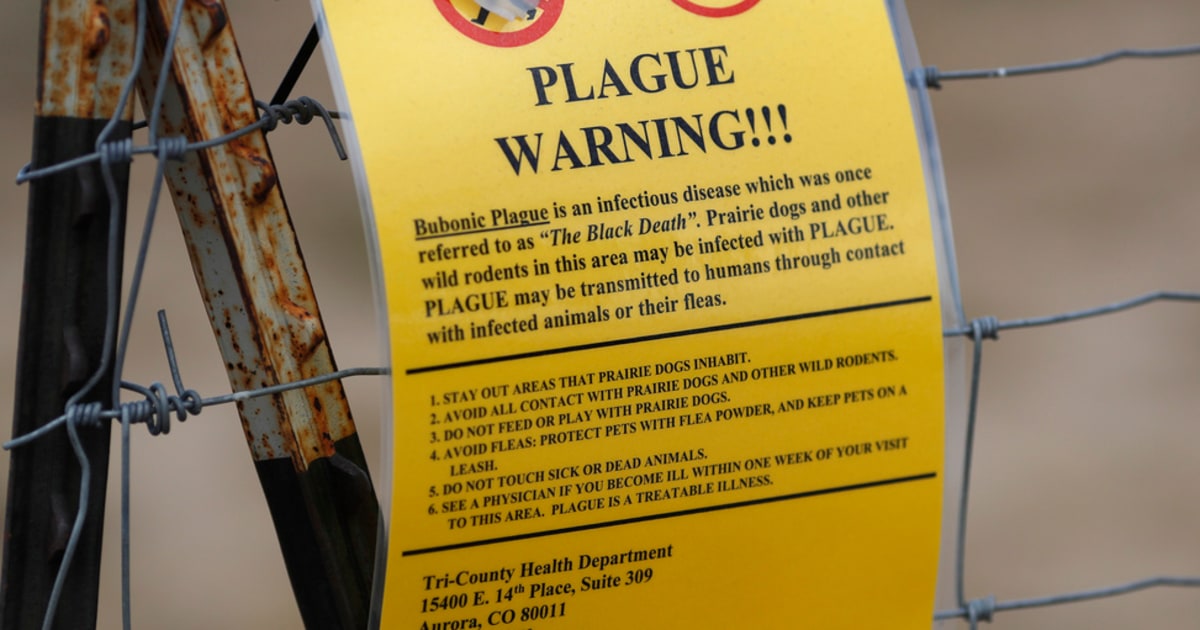By Rebecca Boone -
The Associated Press
Health authorities in central Oregon reported this week a case of bubonic plague: a state resident who is believed to have contracted the disease from a sick cat.
Both the infected resident and his close contacts have received medication, according to public health officials, and community members are considered not at risk.
The transmitting cat also received treatment, but did not survive.
The plague is not common, but it is also not unusual in the western United States, where a few cases are recorded each year.
It's different from Alaska smallpox, a rare, recently discovered disease that killed a man in Alaska last month.
Below are some details to know about what the plague is, who is at risk, and how a disease that was once a harbinger of death has become a treatable illness.
A sign warning about the plague is displayed in a park near the Rocky Mounty Arsenal Wildlife Refuge in the Colorado town of Commerce on Aug. 10, 2019. Associated Press
What is the plague?
Plague is an infectious disease that can affect mammals.
It is caused by the bacteria Yersinia pestis, which is transmitted by rodents and fleas.
According to the U.S. Centers for Disease Control and Prevention (CDC), plague bacteria can die if exposed to sunlight or dry out when on surfaces.
Humans and pets suspected of being sick with plague are usually treated with antibiotics and sometimes other medical procedures.
Plague symptoms can manifest in several ways.
Bubonic plague – the type contracted by the Oregon resident – occurs when plague bacteria enter the lymph nodes:
it can cause fever, headache, weakness, and swollen and painful lymph nodes.
Transmission usually occurs through the bite of an infected flea, according to the CDC.
Symptoms of septicemic plague occur if the bacteria enters the bloodstream.
They may appear at the beginning or after bubonic plague is left untreated.
This form of plague causes the same fever, chills and weakness, as well as abdominal pain,
shock
and sometimes other symptoms such as
bleeding on the skin
and blackening of the fingers, toes or nose.
According to the CDC, this form is contracted from flea bites or from touching an infected animal.
Pneumonic plague is the most serious form of the disease, and occurs when the bacteria enters the lungs.
Pneumonic plague adds rapidly developing pneumonia to the list of plague symptoms.
It is the only form of plague that can be transmitted from person to person by inhalation of infectious droplets.
All forms of plague are treatable with common antibiotics
, and people who receive treatment quickly are more likely to recover completely, according to the CDC.
What is the risk of contracting the plague?
In the United States, there are an average of seven cases of human plague per year, according to the CDC, and about 80% of them correspond to the bubonic form of the disease.
Most of those cases occurred in rural areas of the west and southwest of the country.
A central Oregon welder contracted the disease in 2012 when he removed a rodent from the mouth of his choking cat;
He survived but
lost the tips of his fingers and toes
to the disease.
A Colorado teenager died as a result of the condition he became infected with while hunting in 2015. Colorado authorities confirmed at least two cases last year, one of them fatal.
[Uterine cancer kills thousands of women a year in the US]
Worldwide, most human cases of plague in recent decades have occurred in people living in rural towns and villages in Africa, especially in Madagascar and the Congo, according to the Cleveland Clinic.
People can reduce the risk of plague by keeping their homes and outdoor areas less attractive to rodents, by removing weeds and trash, and by keeping pet food inaccessible to them.
Squirrels and rats can carry plague, as can other rodents, so people with bird and squirrel feeders should be aware of the risks if they live in areas with a plague outbreak.
The CDC has stated that repellents with DEET (N,N-diethyl-meta-toluamide)
can also help protect people from
rodent fleas when camping or working outdoors.
Flea products can help prevent fleas from infecting pets.
If a pet gets sick, they should be taken to the veterinarian as soon as possible, according to the CDC.
Is the plague a disease of the Middle Ages?
The Black Death of the 14th century was perhaps the best-known plague epidemic, killing up to half the world's population as it spread across Europe, the Middle East and North Africa.
The disease began to devastate communities in the Middle East and Europe between 1347 and 1351, and significant outbreaks occurred over the next 400 years.
[Replacing salt with another condiment can reduce the risk of hypertension that afflicts many Latinos, according to a study]
An earlier major plague pandemic, known as the Plague of Justinian, began in Rome around the year 541 and continued to occur for the next two hundred years.
The third great plague pandemic began in the Yunnan region of China in the mid-19th century and spread along trade routes until reaching Hong Kong and Bombay about 40 years later.
It reached every continent except Antarctica, according to the Cleveland Clinic, and is estimated to have killed about 12 million people in China and India alone.
At the end of the 19th century, an effective treatment with an antiserum was developed.
That treatment was replaced by even more effective antibiotics a few decades later.
[These fungi threaten the health of millions around the world: why there are fewer and fewer cures]
Although plague remains a serious disease, antibiotic and other supportive therapy
is effective even for the most dangerous form, pneumonic
, when patients are treated early, according to the World Health Organization (WHO).

